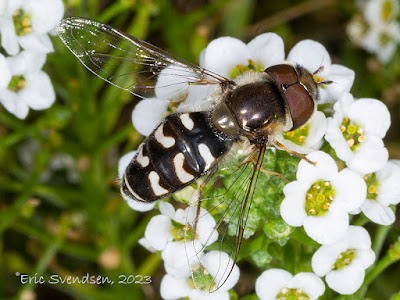The pied hoverfly, flower fly, or syrphid fly?
 |
| A pied hoverfly taking nectar from flowers. |
It turns out that hoverfly, flower fly, and syrphid fly are all interchangeable terms. They all refer to the same group of dipterans (true flies). North America uses the term flower fly while the rest of the world seems to identify them as hoverflies. Syrphid comes from the family Syrphidea, a specialized group of flies whose adults eat nectar; the larvae feed on different foods depending on the species.
I photographed this particular adult in September of last year while we were camping in the Okanagan. It may very well be Scaeva pyrastri, a species of flower fly found around much of the world. The larvae are beneficial insects feeding on aphids. I read one account that suggested a single larva may consume as many as 500 aphids before reaching maturity. If you want to see the larva of this species, click here.
Female flower flies have a space between the compound eyes while in males they are connected. The above fly is a male as the compound eyes converge at the midline. Females lay eggs one at a time, preferably near aphids. According to the website treefruit.wsu.edu, "Despite being blind and legless, the larvae move about and locate prey very efficiently. Often a larva will lift an aphid off the leaf surface while sucking out its body fluids. When mature, larvae go to the ground to transform into pupae and eventually to adult flies. The life cycle takes 2 to 4 weeks to complete."
I always find nature amazing with its great diversity and specific niches that exist. The pied hoverfly is no exception; young feed on aphids and the adults help with pollination. And, I find the adults kind of pretty, in their own way.
Thanks for reading.
Eric Svendsen www.ericspix.com



Comments
Post a Comment